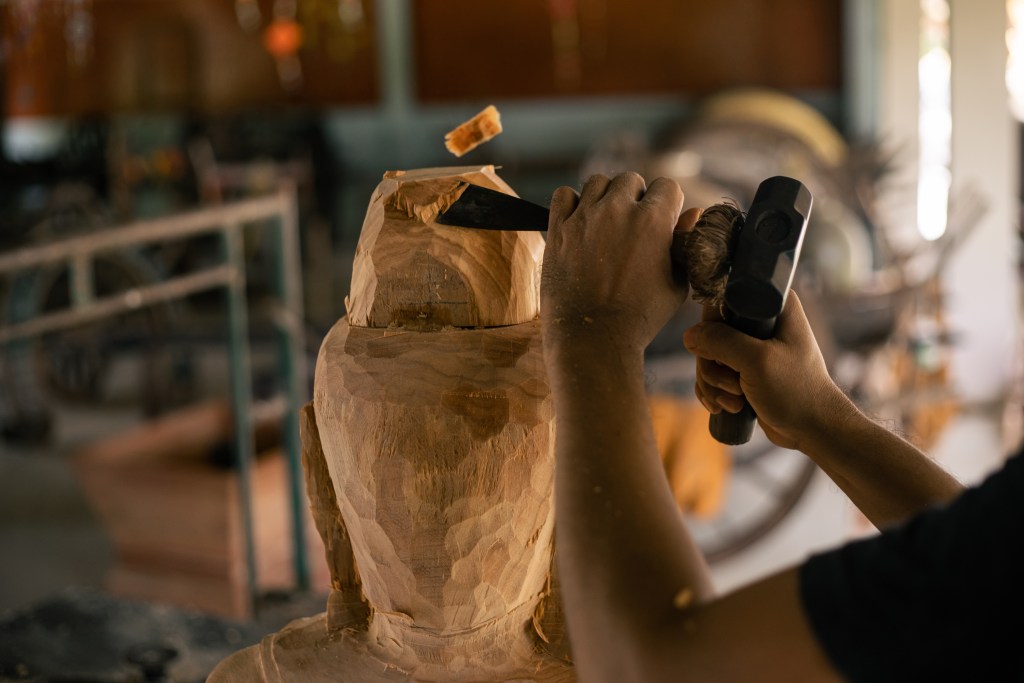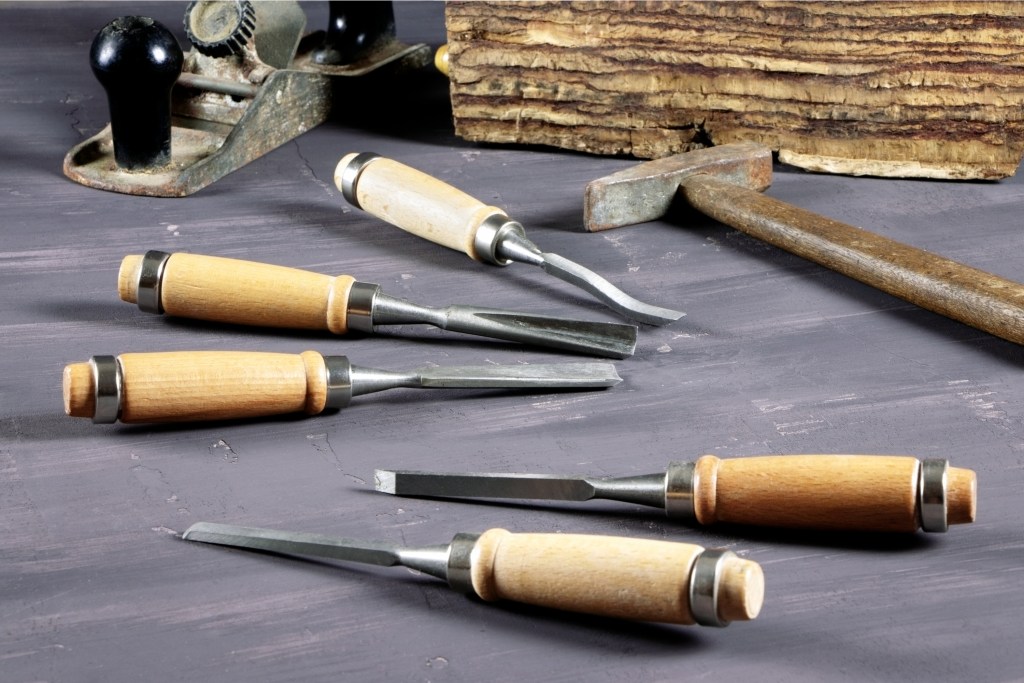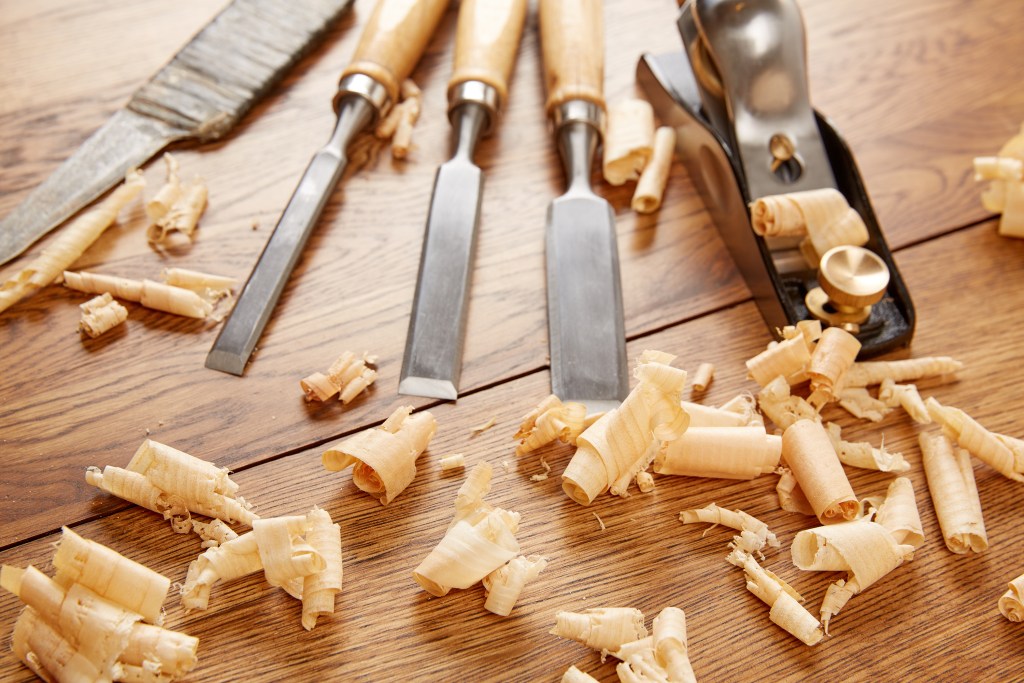A chisel is a tool that humankind has been using for centuries. From creating artistic sculptures out of stone to crafting furniture, chisels are essential to have in your toolbox.
The specific types of chisels you will need vary depending on the kind of job. There are chisels for wood, masonry, metal, and stone. Check out this list of chisels and their uses to help you tackle your next project.

Chisels for wood
When it comes to woodworking, three types of chisels are most common: bench chisels, paring chisels, and mortise chisels.
Bench chisels
These chisels get their name from being one of the most commonly used chisels by woodworkers because they always leave these tools sitting on their workbench. They typically have an equally sized blade and handle, both around 5 inches in length. Bench chisels are best for chopping, paring, trimming, and wood joinery.
Bench chisels also come in variations of firmer and beveled-edge models. Firmer chisels usually have shorter blades and are best for making 90-degree angels. Beveled-edge chisels are the most common type, and as the name suggests, they have a beveled side with a straight edge.
Paring chisels
Paring chisels are more delicate and made with thinner steel than bench chisels. Although they have beveled edges, they’re designed for precision carving and you shouldn’t strike them with a mallet. These chisels come in handy when trying to shave off thin layers of wood by hand and when working with more challenging or unique types of wood.
Mortise chisels
These are among the sturdiest and most durable chisels. Named for their primary purpose of forming mortise joints, these chisels have a 30- to 40-degree edge and can withstand multiple hammer blows over time. Mortise chisels are also sometimes used for stone working because of their durability.
Chisels for metal
Metal chisels describe not only what they’re made of, but also what they’re used for. These tools can manipulate metals that are softer than the chisel itself. The most common types are cold, cape, gouge, and round chisels.
Cold chisels
This type of chisel features reinforced steel from the handle to the blade tip. Cold chisels are most commonly used for cracking bolts and nuts. They get their name for their ability to work on cold steel instead of heat-treated steel shaped during the forging process.
Cape chisels
Cape chisels have a long, tapered point. They’re most useful for carving finely detailed artwork into metal and for cutting keyways or other precision metalwork.
Gouge chisels
These are robust chisels shaped with half-moon blades designed to make circular grooves in metal.
Round chisels
Round chisels don’t look like your conventional chisel. They come in full and half-rounded tips and you use them for making channels in metal. Round chisels are most common for working with metal framing.

Masonry chisels
Masonry chisels get the job done when working with cement, brick, and stone. There are general multi-use masonry chisels and specialized ones like concrete, brick/bolster, and stone chisels.
Multi-use masonry chisels
These heavy-duty chisels are designed for use on brick, stone, concrete, and other tough materials. Masonry chisels are durable and can withstand heavy hammering for tough jobs, but you can also use them for precision tasks.
Concrete chisels
Concrete chisels come to a point at the tip, unlike most chisels that have a flat end. They also have an oversized butt to assist in making contact with a mallet. Concrete chisels can make delicate carvings into concrete or be used to demo areas of concrete that require a softer touch.
Brick/bolster chisels
Best used for cutting bricks, this chisel type has a short handle with a wide, sharp blade. You should only use bolster chisels to cut bricks. Using them for other tasks can easily damage their precision edge.
Stone chisels
Stone chisels are another highly durable tool designed for stone crafting. Stone chisels are capable of breaking down rugged rocks, but you can also use them for fine artistic details.

Specialty chisels
Now that we’ve covered the main types of chisels and their uses, we’ll briefly touch on some specialty models. There are many more types of chisels that are variations of the chisels that we already covered. Each specialty chisel is designed with one purpose in mind.
Japanese chisel: Made of extremely hard steel at its blade’s cutting edge and softer steel on the shaft. Use for precision cuts in unique wood types.
Lathe chisel: Designed to work in tandem with a specialty woodworking device that spins the wood while the chisel carves out designs. Use for crafting furniture.
Curved chisel: Comes with a curved blade and a straight shaft or a curved shaft and a straight blade. Use to create specialty designs and to take our more wood in a single pass.
Skew chisel: Advanced woodworkers use these because of their versatility and sharpness. Use for V-cuts, smoothing, and beads.
Dovetail chisel: Although beveled-edge chisels are used for dovetail joints, these chisels are designed with the sole purpose of creating them.
Power chisel: Like a power drill with changeable bits, power chisels take out the hammering work and provide a wide array of interchangeable chisel heads.
Final thoughts on chisel tools
As you can tell, there are dozens of different chisels and each is designed for a specific purpose. If you’re starting out, consider a chisel set. Toolmakers offer wood, metal, and masonry chisel kits. Their prices vary depending on the offerings, but buying in bulk can mean significant savings instead of buying chisels individually.
Editors' Recommendations
- How to crimp wires together in 4 easy steps
- What is a general contractor and what do they do?
- Find use for these handy products in your workspace
- What is the typical salary for a construction management job?
- Which food truck apps should you use for your business?




